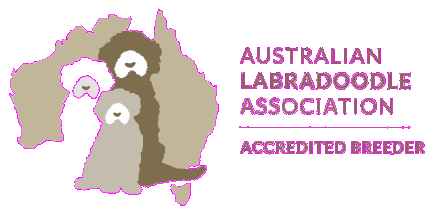COLOUR
All content regarding colour is compliments of the Australian Labradoodle Association web site. Please visit the ALA website to see more info and pictures of these wonderful colours and information on our breed standard and breed history.
NOTE: It is normal that all colours may show bleaching and discolouration over the topcoat, referred to as sunning, this is quite expected and acceptable. The Australian Labradoodle is an active dog and often a service dog that enjoys the outdoors.
Chalk
This colour should be a white colour but when compared to white is rather a chalkywhite in colour. Nose pigment to be Black or Rose.
Cream
This colour should be a creamy colouring sometimes with apricot/gold tinting, all shades of cream are acceptable. Nose pigment to be Black or Rose.
Gold
This colour has also been referred to, as “apricot” should be the colour of the inside of a ripe apricot to varying shades of rich Gold in colour. A true Gold should not have a lighter root than the outer coat and preferable have an even colouration over the entire body. This colour may fade as the dog grows older. Nose pigment to be Black in colour.
Caramel
This colour ranges from a rich gold through to a deep red the preferred colour is very much the same colour as its namesake ‘caramel’ with even colouration over the entire body. Nose pigment to be Rose in colour.
Red
This colour should be a solid even rich red in colour. A true red should not be lighter at the root than the outer coat. Reds can fade as the dog grows older. Nose pigment to be Black. [Rare colour group]
Black
This colour should be a solid black in colour with no sprinkling of any other colour through the coat. Nose pigment to be Black.
Silver
This colour can range in shades from very light pewter in colour to a dark charcoal in colour it is preferred to see an even colour through the coat but acceptable to see uneven layering of colour in the coat. Silvers are born Black with the coat colour developing over time (1-3 yrs). Nose pigment to be Black.
Blue
This colour should be a dark to medium smoky blue in colour. Blues are born Black but will have a Blue/Grey skin pigment. The blue coat colour will develop over time (1-3yrs) but as a developed adult should have an even coat colour. Nose pigment to be Blue/Grey [matching the skin pigmentation]. [Rare colour group]
Chocolate
This colour should be a dark rich chocolate in colour. True chocolates are born almost black in colour and maintain the rich dark colour throughout their lifetime. Colour should be even. Nose pigment to be Rose in colour [matching the coat colour]. [Rare colour group]
Cafe
This colour ranges from a milk chocolate to silver-beige in colour and will develop over time (1-3yrs). Nose pigment to be Rose in colour [matching the coat colour].
Lavender
This colour has a definite smoky lavender chocolate colour giving an almost pink to lilac appearance. Lavender dogs are born chocolate and will develop over time (1-3yrs). Nose pigment to be Rose in colour [matching the coat colour]. [Rare colour group]
Parchment
This colour is a creamy beige chocolate colour reminiscent of a cup of coffee with a generous addition of milk. Parchment dogs are born milk chocolate and will develop over time (1-3yrs). From a distance adult dogs can be mistaken for a dark or smoky cream. Nose pigment to be Rose in colour. [Rare colour group]
Parti
At least fifty percent white, with spots or patches of any other above solid colour. The head can be of a solid colour but white muzzle, blaze, or white muzzle/blaze combination (preferably symmetrical) are equally acceptable. Full or partial saddles are acceptable, as long as they do not exceed the colour proportion, but are not preferred. Ticking in the white of the coat is acceptable but not preferred. Nose pigment to match the solid colour requirements as listed above.
Phantom
Solid base colour with sharply defined markings of a second colour appearing above each eye, on the sides of the muzzle, on the throat and forechest, or in a chin and forechest bowtie pattern as well as on all four legs and feet, and below the tail. A phantom without clearly defined face markings or one that presents with its whole face coloured in the second colour is acceptable, as long as it maintains all the other specified body markings. Any combination of acceptable colours is allowed. Nose pigment should follow requirements listed above based on the Solid base colour.
COATS
All content regarding size and coats of the Australian Labradoodle is compliments of the Australian Labradoodle Association web site. Please visit the ALA site to see photos of coat type.
Coat length should be 4-6 inches long. It should be straight, wavy or forming spirals and should naturally grow in staples with a soft texture.
It should not be too thick or dense nor should it be fluffy or fuzzy. It should be a single coat, any sign of a double coat is a fault.
The ideal Fleece and Wool coats can be spun successfully. Hair coat [Hair texture that sheds] is undesirable and is a major fault.
It is important that the coat gives the impression of being a fleece in type rather than dog hair.
Fleece
Texture should be light and silky similar to the texture of the Angora Goat. Appearing to contain a silky lanolin in texture. Appearance can range from an almost straight loosely waved to an obviously waved coat, Kemp is often found around eyes and along the top line. The absence of Kemp is highly prized.
Wool
The texture is denser than that of the Fleece with a similar texture to that of Lambs Wool. Appearing to contain a sheep lanolin in texture. The ideal wool coat should hang in loose hollow spirals. It is acceptable to exhibit a spring appearance rather than spiral but a sprung wool coat is undesirable. An overly thick or dense coat is also undesirable. There should be no body odor or shedding in the Fleece and Wool coat.
Hair
This coat has odor and sheds in varying degrees, (usually seen in the early generation dogs). It is acceptable to see a coat change from the puppy to adult coat, and also during hormonal changes in fertile bitches. This coat does not shed, but should be groomed out.
SIZES
Standard
21 to 24 (not over 25) inches or about 53-63cm from the wither to ground measurement. The ideal size for the female is 21-23 inches and the male is 22-24 inches. Weight range tends toward 23-30kg. Oversize is a major fault.
Medium
17-20 inches (not over 21 ) inches or about 43-52cm from the wither to ground measurement. The ideal size for the female is 17-19 inches and the male is 18-20 inches. Weight range tends towards 13-20kg.
Miniature
14-16 (not over 17) inches or about 35-42cm from the wither to ground measurement. There is no correlation between height and sex in the Miniature size. Weight range tends towards 7-12kg. Undersize is a major fault.
MORE INFO
For more information about Australian Labradoodles please visit the following websites.
Australian Labradoodle Association – www.laa.org.au
ES& N – www.laa.org.au/breeders-esan.htm
Prcd-PRA – www.laa.org.au/breeders-dna.htm
Labradoodle Colours – www.laa.org.au/lab-colours.htm
Labradoodle Breed standard/sizes – www.laa.org.au/breeders-breed_standard.html
Nicnak Labradoodles – www.nicnaklabradoodles.com.au
Tallai Australian Labradoodles – www.tallai-australian-labradoodles.com
Rocky Creek Vineyard Labradoodles – www.australianlabradoodles.com.au
Rusty Amber Australian Labradoodles – www.labradoodles.au.com
Animal Stars – www.animalstars.com.au
Jetpets Animal Transport – http://www.jetpets.com.au
Unusual Dog names – www.doggynames.com/search/search.asp



